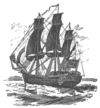George Pratt (missionary)
George Pratt (1817–1894) was a missionary with the London Missionary Society who lived in Samoa for forty years from 1839–1879, mostly on the island of Savai'i. Pratt was from Portsea, Portsmouth in England.[1] He also served in Niue, the Loyalty Islands and New Guinea.[2] In Samoa, Pratt lived at a mission station in Matautu[3] on the north coast of Savai'i island.[4]
First Samoan dictionary 1862
Pratt is particularly notable for being the first person to document the Samoan language. He authored the first grammar and dictionary of the language, A Grammar and Dictionary of the Samoan Language, with English and Samoan Vocabulary, which was first printed in 1862 at the Samoa Mission Press.[5] Subsequent editions were published in 1876, 1893, and 1911. Reprints have been issued in 1960, 1977, and 1984.[6]
Samoan songs and myths 1891
He also collected Samoan songs and myths and translated them into a publication Some Folk-songs and Myths from Samoa, published in 1891. In this work is a section Samoan Custom: Analogous to those of the Israelites, where he wrote about cultural similarities including the importance of the number 7, embalming, natural eloquence, rod or staff of office, heads cut off in war, the use of slings and stones in war, possessions by evil spirits, the 'near sacred' relationships between brothers and sisters, calling the name of the chief who is to drink during ceremony, the giving of names and circumcision. [7]
Pratt's valuable Samoan work records many old words of special interest - specialist terminology, archaic words and names in Samoan tradition. It contains sections on Samoan poetry and proverbs, and an extensive grammatical sketch.[8]
| “ | For my own amusement in 1875 I wrote out a syntax of the Samoan Grammar. I was led to do this by observing, while reading Nordheimer's Hebrew Grammar, that the Samoan, in many points, resembled the Hebrew. Shortly afterwards the Rev. S. J. Whitmee asked me to contribute the Samoan part of a comparative Malayo-Polynesian Dictionary. I at once, with the aid of pundits, commenced revising the first edition of my Dictionary, which was printed at the Samoan Mission Press in 1862. I read through the Hawaii, Māori, Tahiti, and Fiji Dictionaries, and from these I obtained some words which occur also in the Samoan dialect, but which had been overlooked in the first edition. I also culled words and examples from Samoan genealogical accounts, songs, traditionary tales, proverbs, &c. In this way I have been enabled to add over four thousand new words or new meanings....That all Samoan words have been collected it would be useless to affirm. I would fain have had several years during which to go on collecting, but must needs be content to go to press with such as I have, as a new edition is called for, the former being out of print. | ” | |
| — George Pratt, Matautu, Island of Savai'i, June 5, 1876.[8] | |||
References
- ↑ Garrett, John (1982). To live among the stars: Christian origins in Oceania. University of the South Pacific. p. 126. ISBN 2-8254-0692-9. Retrieved 5 December 2009.
- ↑ Ron Crocombe, Majorie Crocombe. Works of ta'unga: records of a polynesian traveller in the south seas, 1833-1896. University of the South Pacific. p. 19. ISBN 982-02-0232-9.
- ↑ Tuvale, Te'o. "An Account of Samoan History up to 1918". NZ Electronic Text Centre, Victoria University of Wellington. Retrieved 5 December 2009.
- ↑ Garrett, John (1982). To live among the stars: Christian origins in Oceania. University of the South Pacific. p. 126. ISBN 2-8254-0692-9. Retrieved 5 December 2009.
- ↑ "New Zealand Electronic Text Centre". Retrieved 2009-04-16.
- ↑ "Stockholms universitet: Polynesian Literature List". Retrieved 2009-04-16.
- ↑ "Some Folk-Songs and Myths from Samoa". New Zealand Electronic Centre, Victoria University of Wellington, NZ Licence CC-BY-SA 3.0. Retrieved 8 December 2009.
- 1 2 Pratt, George. "Title: A Grammar and Dictionary of the Samoan Language, with English and Samoan vocabulary, NZ Licence CC-BY-SA 3.0". NZ Electronic Text Centre, Victoria University of Wellington. Retrieved 5 December 2009.
